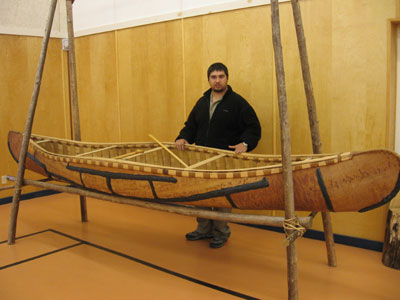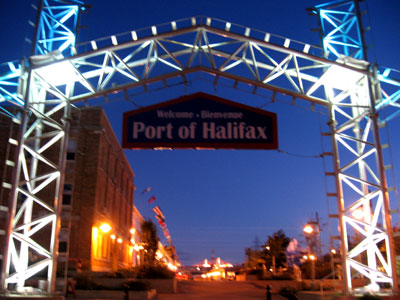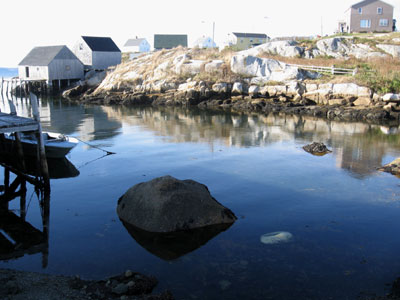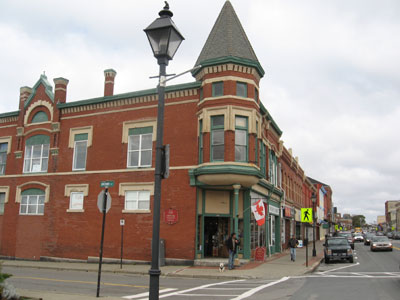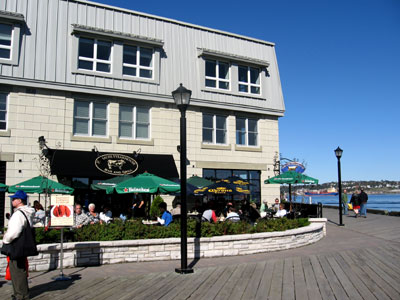About an hour after my departure from Annapolis Royal after a beautiful drive along the shoreline of the Annapolis Basin and through the early fall colours of the Bear River Valley, (also known as “Little Switzerland”. I arrived at the Bear River First Nation Heritage and Cultural Centre. I was greeted by Wanda Joudry-Finigan and Robert (Robbie) McEwan, while Frederick Harlow was manning the cash register. All are members of the Bear River First Nation, and Wanda and Robbie proceeded to celebrate my arrival with a special welcome song.

Wanda and Robbie welcome me.
Wanda explained that the song invites our mutual relatives, grandfathers and ancestors to join us at this occasion. The lobby of the Centre holds various artifacts and a Heritage Gallery that pays homage to current and former Chiefs and Elders of the Bear River First Nation. Wanda pointed out present Chief Frank Meuse Junior who also operates a lodge for adults and youth alike who wish to learn about the Mi’kmaq culture. Another image was of Agnes Potter, a celebrated leader and respected Elder of the Bear River First Nation.

The Bear River Heritage Gallery
Then I was invited to view a brief movie about Willie Meuse, Frank’s grandfather, shown in footage from the 1930s on the Bear River. The film also highlighted the construction and launching of the first birch bark canoe built since 1927. The launching took place in 2004 and speaks to the importance of the ancestors.
We left the vestibule and entered a large multi-purpose room housing a variety of interpretive displays about the life and history of the Mi’kmaq First Nation. This room is also used for theatre productions, games of sports for the youth, community card parties, holiday feasts and presentations. Frederick joined me and gave me an overview of the birch bark canoe. He explained that the canoe weighs about 90 to 95 pounds and was constructed using authentic historical canoe-building methods used in the area. The canoe is a sea-going canoe, evidenced by the high rise in the middle. Fresh-water canoes do not feature a rise in the middle of the canoe.

Frederick shows me the birch bark canoe
The vessel is constructed of various types of wood including ash and birch and the outside is covered with birch bark. Any potential openings in the canoe’s skin are patched up with a mixture of spruce gum and bear grease. Canoes used to be the main form of transportation for the First Nations People and their navigation skills, fishing and hunting knowledge helped the French settlers when they first came to this area in the 1600s. This life-size canoe was made by Todd Labrador and Cory Ryan who is a seventh generation descendent of Malti Pictou, a well-known Bear River Mi’kmaq guide. Before Cory, he was the last person to make a birch bark canoe in the area.
The next exhibit featured a variety of arts and crafts that are produced here using Mi’kmaq artistic traditions. Robbie came over to give me more insight into some of the local arts and crafts. He explained that leather is worked to produce mittens, jackets, dresses, moccasins and other items. Dreamcatchers are an important symbol to the Mi’kmaq. With their intricate web-like design they are hung to catch dreams floating through the night air. There is a saying that dreamcatchers let the good dreams through but protect you from the bad dreams.

Robbie explains the various arts and crafts
Jewellery is made using a variety of glass beads, bone beads as well as imitation sinew. In the past moose tendons were used to produce the pendants and bracelets. Decorated deer and moose hide are available for purchase as well. Robert indicated that he recently made an ornate dress for a native chief in Newfoundland. His artistic skills are evidenced by some of the most impressive pieces of work: Robert showed me a decorative jewellery box that he is currently working on. The box is made of birch bark and porcupine quills, bordered with sweet grass whose scent I was able to smell. He explained that porcupine quills are easily removed from the animal, and they are essentially used to stitch an elaborate design. For each quill a hole is poked and the quill is pulled through. By the time this item is finished, Robert will have invested over 200 hours to produce the elaborate pattern on this decorative box.

A beautiful birch bark box with porcupine quills
Wanda joined us and took me to a display of a wigwam to explain certain rituals and conventions that would be adhered to in First Nations encampments. Visitors would be invited to sit in the most honourable space in the home or wigwam. The same would go for children so they would be able to see everything to the left and to the right of them in order to be able to learn. During winter mats made from rush would be used for insulation against the cold. Baskets were hand- made in order to harvest scallop, clams, or mussels. Each of these particular baskets could hold up to 10 pounds of seafood. Other baskets made from ash were used for potato and apple picking. These baskets were hand-made in large quantities in the 1900s as a major means of economic survival in changing times. Today these baskets are sold as decorative items.

Wandy shows me the sharp claws of a bear
